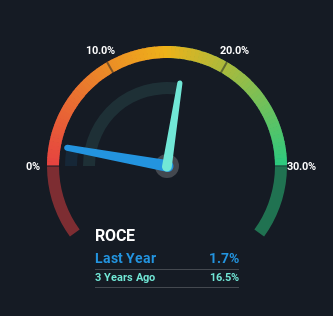- United Kingdom
- /
- Specialty Stores
- /
- LSE:MOTR
The Returns On Capital At Motorpoint Group (LON:MOTR) Don't Inspire Confidence
What financial metrics can indicate to us that a company is maturing or even in decline? More often than not, we'll see a declining return on capital employed (ROCE) and a declining amount of capital employed. This indicates to us that the business is not only shrinking the size of its net assets, but its returns are falling as well. Having said that, after a brief look, Motorpoint Group (LON:MOTR) we aren't filled with optimism, but let's investigate further.
Return On Capital Employed (ROCE): What Is It?
For those who don't know, ROCE is a measure of a company's yearly pre-tax profit (its return), relative to the capital employed in the business. The formula for this calculation on Motorpoint Group is:
Return on Capital Employed = Earnings Before Interest and Tax (EBIT) ÷ (Total Assets - Current Liabilities)
0.017 = UK£1.5m ÷ (UK£198m - UK£111m) (Based on the trailing twelve months to March 2024).
So, Motorpoint Group has an ROCE of 1.7%. In absolute terms, that's a low return and it also under-performs the Specialty Retail industry average of 9.8%.
Check out our latest analysis for Motorpoint Group

Above you can see how the current ROCE for Motorpoint Group compares to its prior returns on capital, but there's only so much you can tell from the past. If you're interested, you can view the analysts predictions in our free analyst report for Motorpoint Group .
The Trend Of ROCE
In terms of Motorpoint Group's historical ROCE movements, the trend doesn't inspire confidence. Unfortunately the returns on capital have diminished from the 35% that they were earning five years ago. And on the capital employed front, the business is utilizing roughly the same amount of capital as it was back then. Since returns are falling and the business has the same amount of assets employed, this can suggest it's a mature business that hasn't had much growth in the last five years. So because these trends aren't typically conducive to creating a multi-bagger, we wouldn't hold our breath on Motorpoint Group becoming one if things continue as they have.
On a side note, Motorpoint Group's current liabilities are still rather high at 56% of total assets. This can bring about some risks because the company is basically operating with a rather large reliance on its suppliers or other sorts of short-term creditors. While it's not necessarily a bad thing, it can be beneficial if this ratio is lower.
The Key Takeaway
In summary, it's unfortunate that Motorpoint Group is generating lower returns from the same amount of capital. It should come as no surprise then that the stock has fallen 25% over the last five years, so it looks like investors are recognizing these changes. Unless there is a shift to a more positive trajectory in these metrics, we would look elsewhere.
One more thing: We've identified 2 warning signs with Motorpoint Group (at least 1 which makes us a bit uncomfortable) , and understanding them would certainly be useful.
While Motorpoint Group may not currently earn the highest returns, we've compiled a list of companies that currently earn more than 25% return on equity. Check out this free list here.
New: Manage All Your Stock Portfolios in One Place
We've created the ultimate portfolio companion for stock investors, and it's free.
• Connect an unlimited number of Portfolios and see your total in one currency
• Be alerted to new Warning Signs or Risks via email or mobile
• Track the Fair Value of your stocks
Have feedback on this article? Concerned about the content? Get in touch with us directly. Alternatively, email editorial-team (at) simplywallst.com.
This article by Simply Wall St is general in nature. We provide commentary based on historical data and analyst forecasts only using an unbiased methodology and our articles are not intended to be financial advice. It does not constitute a recommendation to buy or sell any stock, and does not take account of your objectives, or your financial situation. We aim to bring you long-term focused analysis driven by fundamental data. Note that our analysis may not factor in the latest price-sensitive company announcements or qualitative material. Simply Wall St has no position in any stocks mentioned.
About LSE:MOTR
Motorpoint Group
Operates as an omnichannel vehicle retailer in the United Kingdom.
High growth potential with mediocre balance sheet.
Market Insights
Community Narratives



